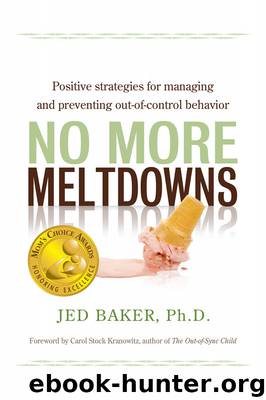No More Meltdowns by Baker Jed

Author:Baker, Jed [Baker, Jed]
Language: eng
Format: epub
ISBN: 978-1-935274-27-8
Publisher: BookBaby
Published: 2010-07-07T16:00:00+00:00
Quick Reference Guide for Problems Avoiding New Foods
CHANGE THE TRIGGERS
Sensory stimulation
– Noise and light: consider quieter areas to try new foods to avoid sensory overload.
– Smells: pick foods with smells similar to that of her favored foods, or gradually introduce foods with new smells.
– Touch: pick foods with textures similar to that of her favored food. For example, a child who only likes macaroni could try other pastas before moving on to other textures.
– Taste: introduce new foods that have tastes similar to that of her favored foods, or begin with sweet items (even candy) to allow the child to be open to trying new things.
Timing of the situation. It is best to try new foods when both adult and child are not rushed and not otherwise too stressed. If mealtimes are usually stressful, with preparation and getting kids to sit down, this may not be the ideal time.
Task difficulty
– Give the child a choice of foods to eat.
– Instead of asking children to eat a large piece of food, create a hierarchy of difficulty from looking at the food, to smelling it, to licking it, to chewing a small piece, and then to swallowing some.
– Use the child’s interests to make the food more appealing. If they like certain animals, make the food look like the animals.
– Use the child’s role models or friends to model eating the new foods. For example, if the child likes a superhero, explain how the superhero eats that food.
Visual supports. Remind the child verbally and with cue cards or posters that she does not have to eat everything, just look, smell, taste, chew, or swallow a little bit. Show her the rewards that await her when she tries the foods.
TEACH SKILLS TO DEAL WITH THE TRIGGERS
Think about what the child likes to do and explain that eating certain foods will give her the strength and ability to do those things (e.g., sports, reading, dancing, etc).
Show the child the effects that those foods have on her role models and good friends. For example, explain how her favorite singer or best friend eats a particularly healthy food.
Explain to the child the way fear works.
– There are true fears and false alarms. True fears keep us away from things that are actually dangerous, such as being afraid to run out in traffic. False alarms keep us away from things that are actually good for us, such as being afraid of healthy food.
– With false alarms, we usually fear the thing until we try it. Once we try it, it turns out to be much better than we thought. Remind her of times when she was afraid of something that was harmless and then it turned out to be okay after she tried it.
– Then help her gradually face her fear by looking, smelling, tasting and then eating the new foods.
TRY REWARD OR LOSS SYSTEMS
For each step of trying a new food, offer a reward. Rewards can include preferred foods, toys, or privileges, or points that add up to buy those things.
Download
This site does not store any files on its server. We only index and link to content provided by other sites. Please contact the content providers to delete copyright contents if any and email us, we'll remove relevant links or contents immediately.
| Behavioral Disorders | Communicative Disorders |
| Gifted Students | Inclusive Education |
| Learning Disabled | Mentally Disabled |
| Physically Disabled |
The Art of Coaching Workbook by Elena Aguilar(50963)
Trainspotting by Irvine Welsh(21517)
Twilight of the Idols With the Antichrist and Ecce Homo by Friedrich Nietzsche(18501)
Fangirl by Rainbow Rowell(9094)
Periodization Training for Sports by Tudor Bompa(8168)
Change Your Questions, Change Your Life by Marilee Adams(7633)
This Is How You Lose Her by Junot Diaz(6778)
Asking the Right Questions: A Guide to Critical Thinking by M. Neil Browne & Stuart M. Keeley(5631)
Grit by Angela Duckworth(5512)
Red Sparrow by Jason Matthews(5390)
Paper Towns by Green John(5086)
Room 212 by Kate Stewart(5035)
Ken Follett - World without end by Ken Follett(4643)
Housekeeping by Marilynne Robinson(4329)
The Sports Rules Book by Human Kinetics(4288)
Double Down (Diary of a Wimpy Kid Book 11) by Jeff Kinney(4204)
Papillon (English) by Henri Charrière(4195)
The Motorcycle Diaries by Ernesto Che Guevara(4009)
Exercise Technique Manual for Resistance Training by National Strength & Conditioning Association(3955)
